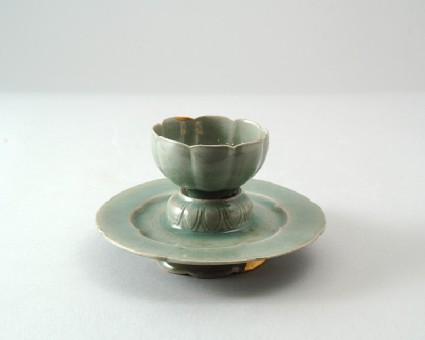Browse: 230 objects
Greenware cup stand with cup
- loan
-
Details
- Associated place
- Date
-
12th century (1101 - 1200)
Koryo Dynasty (AD 935 - 1392)
- Material and technique
- stoneware, thrown, with incised decoration under a green celadon glaze; glazed base; glazed rim
- Dimensions
-
with stand 8.5 cm (height)
without stand 4.5 cm (height)
stand 14.8 cm (diameter)
cup 7.4 cm (diameter)
- Material index
- Technique index
- Object type index
- No. of items
- 2
- Credit line
- Lent by the Sir Alan Barlow Collection Trust.
- Accession no.
- LI1301.104
-
Further reading
University of Sussex, and Arts and Humanities Research Council, The Barlow Collection, supervised by Regina Krahl, Maurice Howard, and Aiden Leeves (Sussex: University of Sussex, 2006), no. C76
Glossary (2)
glaze, stoneware
-
glaze
Vitreous coating applied to the surface of a ceramic to make it impermeable or for decorative effect.
-
stoneware
Ceramic material made of clay which is fired to a temperature of c.1200-1300⁰c and is often buff or grey in colour.
Location
-
- currently in research collection
Objects are sometimes moved to a different location. Our object location data is usually updated on a monthly basis. Contact the Jameel Study Centre if you are planning to visit the museum to see a particular object on display, or would like to arrange an appointment to see an object in our reserve collections.
Publications online
-

The Barlow Collection
This type of fine celadon was made at Sadang-ri, Taegu-myŏn, Kangjin-gun, Chŏlla-namdo, in the first half of the 12th century AD.
The deeply rounded cup has a short outward curved foot, and the stand is shaped like a dish with flat everted rim, a domed, hollow pedestal in the centre and a tall flared foot. Both pieces are of eight-lobed section, with matchingly shaped rim and foot, the dish with radiating grooves on the underside, but the pedestal has a circular rim. The cup is incised with a central flower-head and with small flower sprays in each lobe, both inside and outside, the stand has similar double flower sprays on the rim, fish among waves in the recessed centre, a flower-head on top of the pedestal, and deeply carved pendant petals with finely incised veins around it. The outside is plain, but the foot is incised with foliate sprays. Both pieces are fully covered with a fine transparent glaze of deep blue-green colour. The cup was fired standing on three small spurs which have left marks on the glazed base, and the stand shows three similar marks inside the foot; the foot itself has baked onto the support, which is partly adhering to the glaze. Both pieces have gold-lacquer repairs.
A similar cup and stand from the tomb of King Injong in Changdan-gun, Kyŏnggi-do, in the National Museum of Korea, Seoul.
© 2013 University of Oxford - Ashmolean Museum




